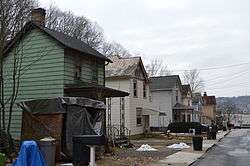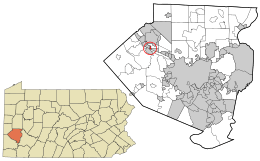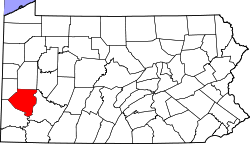Haysville, Pennsylvania
| Haysville | |
|---|---|
| Borough | |
 Houses on River Road | |
 Location in Allegheny County and the U.S. state of Pennsylvania. | |
| Coordinates: 40°31′32″N 80°9′32″W / 40.52556°N 80.15889°WCoordinates: 40°31′32″N 80°9′32″W / 40.52556°N 80.15889°W | |
| Country | United States |
| State | Pennsylvania |
| County | Allegheny |
| Government | |
| • Mayor | Michael Kerr (R) |
| • Council President | Catherine Paff (R) |
| Area[1] | |
| • Total | 0.23 sq mi (0.61 km2) |
| • Land | 0.17 sq mi (0.45 km2) |
| • Water | 0.06 sq mi (0.16 km2) |
| Population (2010) | |
| • Total | 70 |
| • Estimate (2016)[2] | 70 |
| • Density | 406.98/sq mi (156.68/km2) |
| Time zone | UTC-5 (Eastern (EST)) |
| • Summer (DST) | UTC-4 (EDT) |
| FIPS code | 42-33312 |
Haysville is a borough in Allegheny County, Pennsylvania, U.S., along the Ohio River. The population was 70 according to the 2010 census,[3] making it the least-populated municipality (out of 130) in Allegheny County.[4]
Geography
Haysville is located at 40°31′32″N 80°9′32″W / 40.52556°N 80.15889°W (40.525534, -80.158945).[5]
According to the United States Census Bureau, the borough has a total area of 0.3 square miles (0.78 km2), of which 0.2 square miles (0.52 km2) is land and 0.1 square miles (0.26 km2), or 23.08%, is water.
Surrounding and adjacent neighborhoods
Haysville has three land borders with Aleppo Township to the north, Glenfield to the east and Glen Osborne to the west. Across the Ohio River to the south, Haysville runs adjacent with Coraopolis and Neville Township.
Education
Haysville is served by the Quaker Valley School District.
Government and Politics
| Year | Republican | Democratic | Third Parties |
|---|---|---|---|
| 2016 | 58% 23 | 38% 15 | 4% 2 |
| 2012 | 62% 24 | 38% 15 | 0% 0 |
Taxes
School tax millage rate- The Quaker Valley SD (shared with twelve other municipalities) in 2017 was 18.40. This ranked 35th highest/most expensive out of Allegheny County's 45 school districts, between West Allegheny SD (34th highest) and North Allegheny SD (36th highest).[8]
Demographics
| Historical population | |||
|---|---|---|---|
| Census | Pop. | %± | |
| 1910 | 166 | — | |
| 1920 | 173 | 4.2% | |
| 1930 | 192 | 11.0% | |
| 1940 | 169 | −12.0% | |
| 1950 | 177 | 4.7% | |
| 1960 | 143 | −19.2% | |
| 1970 | 154 | 7.7% | |
| 1980 | 117 | −24.0% | |
| 1990 | 100 | −14.5% | |
| 2000 | 78 | −22.0% | |
| 2010 | 70 | −10.3% | |
| Est. 2016 | 70 | [2] | 0.0% |
| Sources:[9][10][11][12][13] | |||
As of the census[12] of 2000, there were 78 people, 36 households, and 21 families residing in the borough. The population density was 389.0 people per square mile (150.6/km²). There were 38 housing units at an average density of 189.5 per square mile (73.4/km²). The racial makeup of the borough was 97.44% White, and 2.56% from two or more races.
There were 36 households, out of which 22.2% had children under the age of 18 living with them, 41.7% were married couples living together, 13.9% had a female householder with no husband present, and 38.9% were non-families. 27.8% of all households were made up of individuals, and 13.9% had someone living alone who was 65 years of age or older. The average household size was 2.17 and the average family size was 2.68.
In the borough the population was spread out, with 15.4% under the age of 18, 9.0% from 18 to 24, 30.8% from 25 to 44, 23.1% from 45 to 64, and 21.8% who were 65 years of age or older. The median age was 42 years. For every 100 females, there were 95.0 males. For every 100 females age 18 and over, there were 78.4 males.
The median income for a household in the borough was $33,750, and the median income for a family was $49,375. Males had a median income of $29,167 versus $21,250 for females. The per capita income for the borough was $53,151. There were 9.5% of families and 17.3% of the population living below the poverty line, including 23.1% of under eighteens and 12.5% of those over 64.
See also
References
- ↑ "2016 U.S. Gazetteer Files". United States Census Bureau. Retrieved Aug 13, 2017.
- 1 2 "Population and Housing Unit Estimates". Retrieved June 9, 2017.
- ↑ "Race, Hispanic or Latino, Age, and Housing Occupancy: 2010 Census Redistricting Data (Public Law 94-171) Summary File (QT-PL), Haysville borough, Pennsylvania". U.S. Census Bureau, American FactFinder 2. Retrieved September 20, 2011.
- ↑ Houser, Mark (28 January 2001). "The cost of local government: 'Fragmentation' epitomized: Experts differ on efficiency of tiny towns". Pittsburgh Tribune-Review. Retrieved 6 August 2010.
- ↑ "US Gazetteer files: 2010, 2000, and 1990". United States Census Bureau. 2011-02-12. Retrieved 2011-04-23.
- ↑ EL. "2012 Allegheny County election". Pittsburgh Tribune-Review. Retrieved 15 October 2017.
- ↑ EL. "2016 Pennsylvani general election..." Pittsburgh Post-Gazette. Retrieved 15 October 2017.
- ↑ EL. "Allegheny County Treasurer". Retrieved 1 September 2017.
- ↑ "Number and Distribution of Inhabitants:Pennsylvania-Tennessee" (PDF). Fifteenth Census. U.S. Census Bureau.
- ↑ "Number of Inhabitants: Pennsylvania" (PDF). 18th Census of the United States. U.S. Census Bureau. Retrieved 22 November 2013.
- ↑ "Pennsylvania: Population and Housing Unit Counts" (PDF). U.S. Census Bureau. Retrieved 22 November 2013.
- 1 2 "American FactFinder". United States Census Bureau. Retrieved 2008-01-31.
- ↑ "Annual Estimates of the Resident Population". U.S. Census Bureau. Retrieved 22 November 2013.
